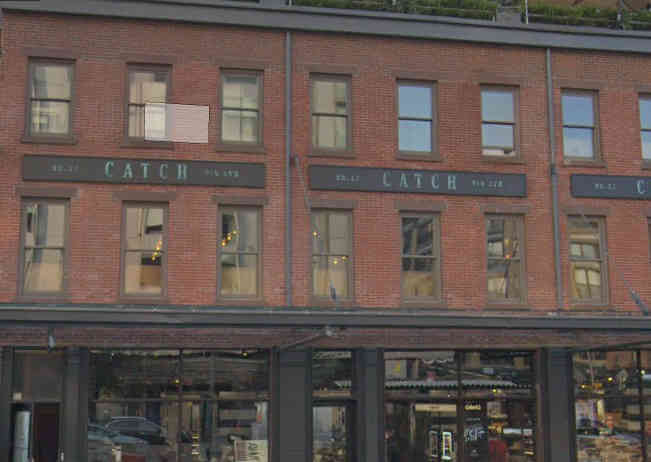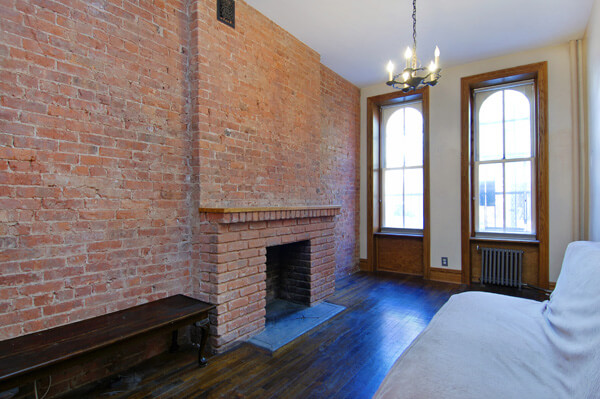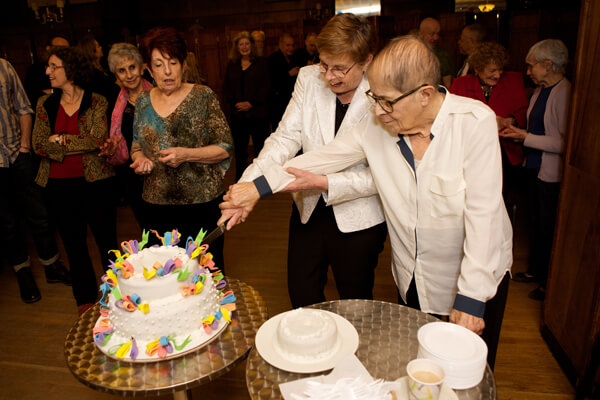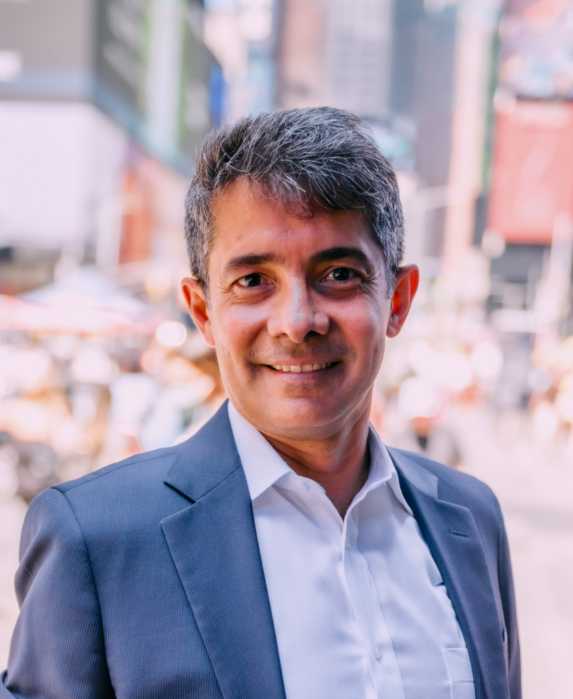Burt Lazarin at at CB4’s West 42nd Street offices, with the emerging Hudson Yards neighborhood in the background. | WINNIE MCCROY
After more than 40 years living in Chelsea, including many serving as a member of Community Board 4, Burt Lazarin has moved to its top ranks. He was recently voted in as the new chair of CB4, taking over for exiting chair Delores Rubin.
“I don’t think of myself as a leader in the traditional sense, because we’re a board of 50 people with lots of skills and expertise,” the out gay community activist said. “I have no problem if we’re at a meeting and the head of the Housing Committee — who knows a lot more about that than I do — takes the lead. My function is to make sure that person is supported, and then to speak for the whole board.”
Lazarin said he won’t be a micromanager who dictates what should happen at every meeting, noting, “That creates problems with members.” Instead, he said, he will let people bring their own expertise to the table.
Longtime pioneering gay Chelsea activist reflects on 40 years of community work
His own field of expertise lies in urban planning. Born in Brooklyn and raised in the Bronx, Lazarin earned his bachelor’s degree at City College, followed by graduate study in Seattle. He has lived in Albany, London, Chile, and Peru, working as an urban planner in South America for two and a half years while in the Peace Corps.
When he first returned to New York, he lived in Brooklyn and worked in consulting with labor unions on contract negotiations. After five years in Brooklyn, he followed a wave of friends migrating to Chelsea, which was emerging as a one of the city’s newest gay enclaves. Thirty-seven years ago, he began a relationship with Frank Ireland, whom he married last June.
“When I moved here in 1977, people asked me, ‘Is it safe?’ — because everything between Ninth Avenue and the river was abandoned,” Lazarin recalled. “There were the hookers and there were the meat trucks but that was it, because the whole area was built in the early 20th century as support for the docks. But by the early ’70s, the finger piers went away, some warehouses became taxi garages, and the whole south side of 23rd Street, which is now expensive townhouses, was abandoned.”
Lazarin fondly recalls the early years of Chelsea’s emergence as a gay neighborhood, speaking wistfully of the Meatpacking District bistro Florent with the framed maps of different cities — many imaginary — that lined its walls. By then, he was a fixture in the neighborhood and ready to invest in its future.
“I’ve always been involved, always been a group person,” said Lazarin. “One thing I did when I first came back was I got involved with a group called Identity House, which at the time was fairly revolutionary.”
The group does peer counseling for the LGBTQ community.
“The personal was political,” Lazarin noted, “and we knew that as we worked helping people come out or with relationship problems, we were changing things. It was a self-governing organization that started in ’71, and I served as coordinator, executive director, and clinical director because for many years I did psychotherapy in addition to contract negotiations.”
Upon his arrival in Chelsea in ‘77, Lazarin banded together with his friends to form another gay organization.
Burt Lazarin and Frank Ireland’s daughter-in-law, Julie Villa, Ireland, Lazarin, and Ireland’s son Ben, a Universal Life minister who officiated over Burt and Frank’s June 2017 wedding. | JAY LAZARIN
“That’s the time when mostly gays were moving into Chelsea and we wanted to have a presence, so we started an organization called the Chelsea Gay Association,” Lazarin recalled. “It was to meet your neighbors, with small breakout groups for safety, theater, and the like. We had regular meetings and connected with block associations, to make allies. We wanted straight allies going to City Council to help pass the Gay Rights Bill, and we got people from the neighborhood to testify in favor of the bill.”
That group lasted until 1982, he said. Identity House still offers walk-in counseling at the LGBT Community Center on West 13th Street.
In the late ’80s, Lazarin also joined the Chelsea Waterside Park Association, where he is currently treasurer. Over time, his activism on community issues would grow.
“I have always been involved, so when I saw the announcement for CB4 members, I took a deep breath, thought, ‘It’s time to shit or get off the pot,’ and sent off the application with two recommendations,” Lazarin said.
He was appointed to CB4 in 2005, later serving on its Business Diversity Task Force. One of the first things he recalls the task force doing was conducting a “windshield survey” — walking block by block to tally up the number of bars and restaurants in the area.
“We wanted to get some idea of what people meant when they said the area was ‘saturated,’” said Lazarin. “Your saturation might be my fun or my opportunity.”
The task force came up with its own definition and kept tabs on new liquor license applications to make sure the community had the chance to weigh in at public hearings.
By that time, Lazarin had already become co-chair of the Business Licenses & Permits Committee.
“We advise and provide opportunity for people in the community to voice objections to specific aspects of a licensee or their method of operations,” Lazarin explained. “Over the years, we have developed a format of ‘deny unless’ the business meets all of our stipulations. If Albany accepts those stipulations, they become legally part of the licensees’ method of operations. Then, if they are not following those stipulations — often things like no amplified music or an earlier closing time — then they’re liable.”
During his time as co-chair of that committee, several businesses have faced community opposition, and Lazarin particularly recalls a fight over the gay sports bar Boxers attempting to move into a stand-alone building on Tenth Avenue near a schoolyard.
“The whole thing was about the 200-foot rule, which means no bars within 200 feet of a schoolyard,” he recalled. “The school was set far back, but people were measuring from door to door, questioning if the emergency exit counted. It became like ‘how many angels can dance on the head of a pin.’ The full board in October 2011 voted to deny Boxer’s application because of ‘proximity’ to the school, which was the real issue — not the exact footage — though we did list stips to be incorporated in a license just in case State Liquor Authority approved it. Boxers litigated the 200-foot rule and subsequently lost and gave up the site.”
They bar eventually moved near Ninth Avenue in Hell’s Kitchen.
More recently, the committee has faced controversies like the drunken brunch crowds at Il Bastardo (whose Seventh Avenue and West 21st Street location has since closed), and a proposed two-level, 20,000-square-foot Meatpacking District Starbucks Reserve Roastery. In the case of Starbucks, Lazarin said, the company essentially ignored CB4’s stipulations process and instead went directly to the State Liquor Authority.
To him, the Business Licenses & Permits Committee’s work is all a balancing act.
“We want to make sure [new businesses] are compatible with existing businesses,” Lazarin said. “We are trying to find balance between both the residents and the people who come in for regional recreation. You have to balance it out, so people who live there are not crazed and abused by the people who come to recreate.”
As chair of CB4, Lazarin now faces an even broader responsibility to maintain balance and deliver a fair deal to Chelsea residents. He was unfazed by the recent announcement that Google would purchase the Chelsea Market building, saying that if he were a businessman he too would see the property’s appeal, given that the rezoning battle was resolved four years ago. He added, however, that he “would hope they honor [seller] Jamestown’s promised community commitments,” and assumes Google will keep the retail portion intact.
“It would be a pretty stupid public relations move to eliminate the Chelsea Market,” he said.
Lazarin said he looks forward to working with City Council Speaker Corey Johnson, who chaired CB4 from 2011 to 2013.
“This is [Johnson’s] district, where his feet are and where he lives, where his New York roots are,” said Lazarin. “We have our priorities, most of which are probably aligned with his, so I don’t see any problems. Not that he isn’t going to be speaker for the whole City Council — but he may have a softer spot for Chelsea.”
Lazarin voiced support for extending the Special West Chelsea District where necessary to protect historic buildings, and said he will spearhead efforts to landmark or otherwise acknowledge buildings like the Federal Houses and the brownstone in the West 20s where Gay Men’s Health Crisis was founded.
Lazarin is also focused on making sure that CB4 gets its promised seat on the board of the Culture Shed, the large performance space being built the middle of Hudson Yards. He also noted the importance of the 7 train extension to the development of Hudson Yards and said the subway need not terminate at 34th Street.
“The tunnel already goes down to 25th Street, so it’s just a matter of extending it down and bumping it up next to 14th Street and Eighth Avenue, and having a cross-platform exchange,” Lazarin said. “It’s time to start thinking and planning for that, as we have that new community integrate with existing neighborhoods.”
Asked his view on the new push for congestion pricing as a solution to Manhattan’s gridlock, he noted that the idea has worked in London, Stockholm, and Singapore.
“There are costs of driving a car into Manhattan — not only individual costs but costs to the community,” Lazarin said. “We often quote that CB4 has one of the highest asthma rates in the city, because of the traffic, the tunnels, the backups, and the tour buses. So, it’s something that could be useful, something that could benefit our district.”

































